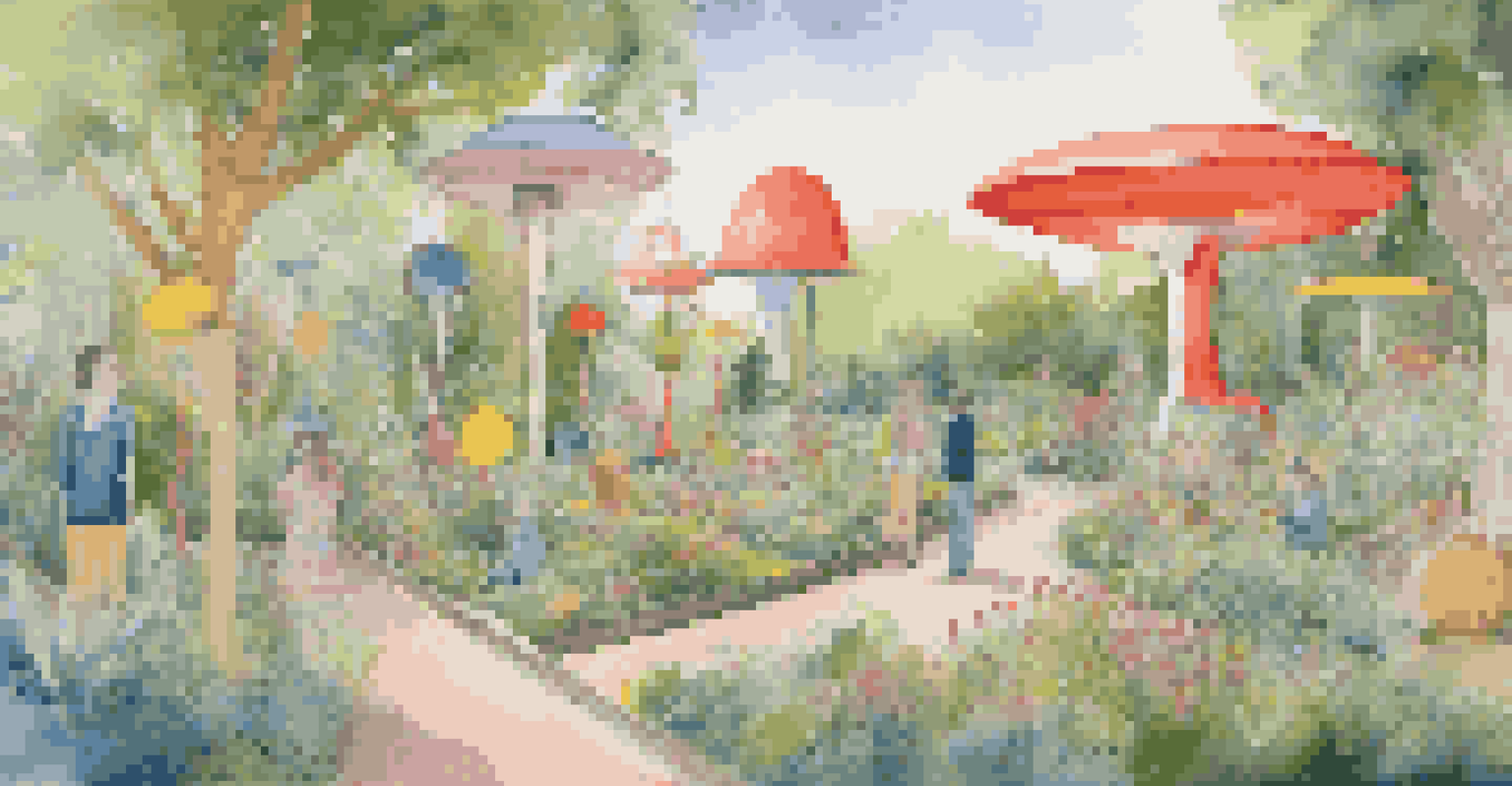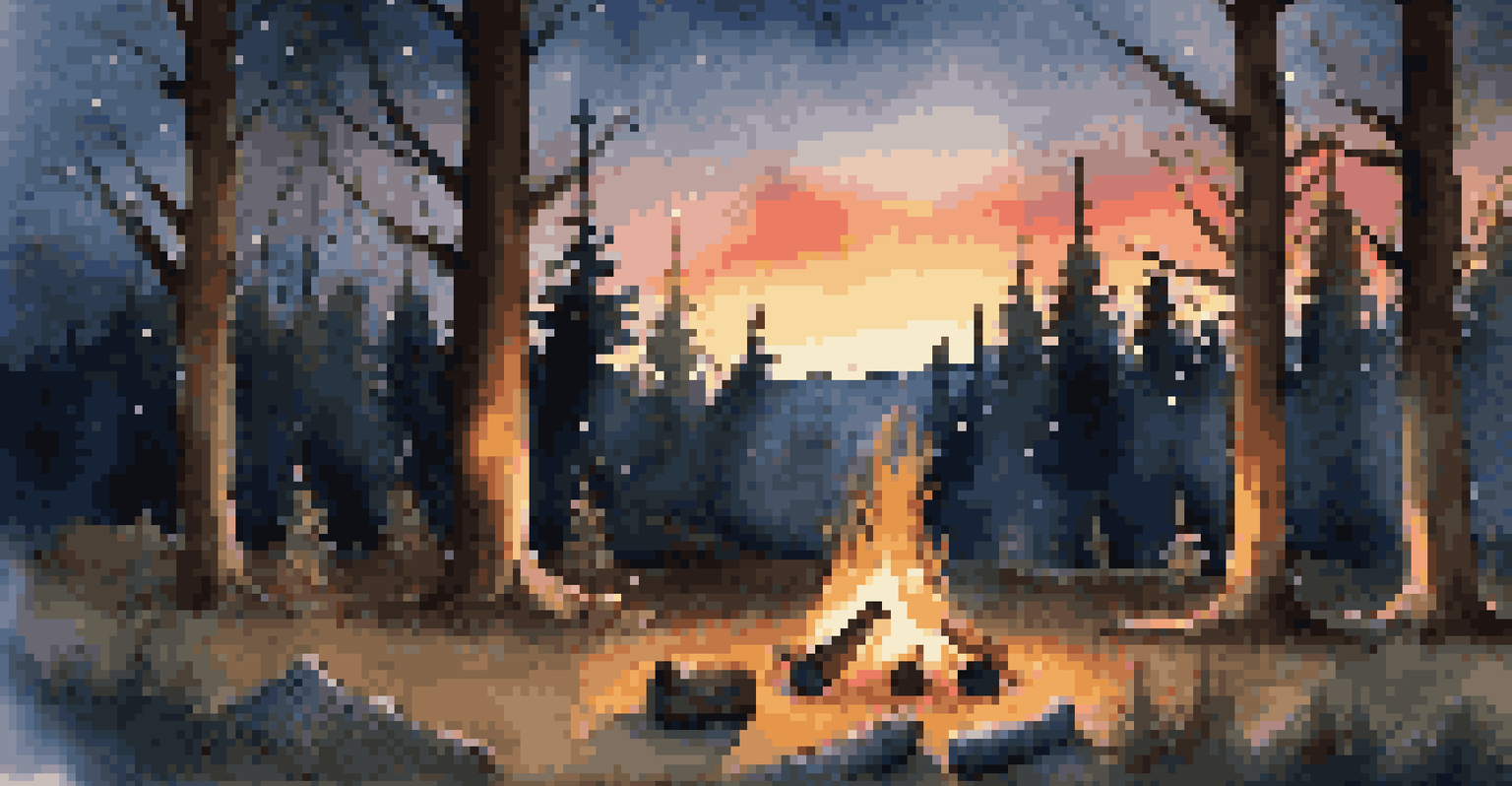Creating Immersive Soundscapes with Creative Coding Techniques

Understanding Soundscapes: The Basics of Audio Environments
Soundscapes refer to the acoustic environment we perceive, encompassing everything from the gentle rustling of leaves to bustling city sounds. They play a crucial role in creating atmosphere, enhancing storytelling, and shaping emotions in various media, such as films, games, and installations. By understanding the elements that compose a soundscape, we can begin to harness their power creatively.
Sound is the vocabulary of nature.
The concept of soundscapes extends beyond simple background noise; it involves layering different sounds to create an immersive experience. Think of it like a painter mixing colors to evoke specific feelings or moods. This blending of sounds can transport listeners to different environments, making them feel as if they are truly part of the scene.
Creative coding allows artists and developers to manipulate soundscapes in innovative ways, opening up a world of possibilities. With basic coding skills, one can experiment with sound generation, manipulation, and interaction, providing a unique approach to crafting audio experiences that captivate audiences.
The Role of Creative Coding in Sound Design
Creative coding is the practice of using programming languages to create art, and in sound design, it serves as a powerful tool for crafting immersive auditory experiences. By using languages like Max/MSP, Pure Data, or SuperCollider, creators can design dynamic soundscapes that react to user input or environmental stimuli. This interactivity adds a layer of engagement that pre-recorded sound cannot achieve.

For example, imagine a virtual forest where the sounds change based on the listener's movements. As you walk deeper into the woods, the volume of bird calls might increase, while distant thunder rumbles ominously. This real-time interaction can enhance the narrative and emotional impact of the experience, making it feel more alive and responsive.
Soundscapes Enhance Immersion
Soundscapes combine various audio elements to create immersive experiences that enhance storytelling and emotional engagement.
Furthermore, creative coding allows for the exploration of generative soundscapes, where algorithms create unique audio experiences each time they are played. This unpredictability not only keeps the experience fresh but also invites listeners to engage in a continuous exploration of sound, blurring the lines between composer and audience.
Tools and Platforms for Creative Sound Coding
Several platforms and tools are available for those interested in creating immersive soundscapes through coding. Software like Ableton Live, combined with Max for Live, enables musicians and sound designers to incorporate interactive elements into their projects seamlessly. This integration allows for the creation of complex sound environments that evolve in real-time.
The best way to predict the future is to create it.
Another popular option is Processing, a flexible software sketchbook that has gained traction in the creative coding community. With its simple syntax and strong visual capabilities, Processing can be used to generate sound and visuals simultaneously, creating a multi-sensory experience. Whether you’re a beginner or a seasoned coder, there’s a tool that fits your needs.
For those looking to dive deeper into the world of sound coding, online communities and resources abound. Websites like Open Processing and GitHub host a plethora of open-source projects, providing inspiration and collaboration opportunities with fellow sound enthusiasts.
Exploring Sound Manipulation Techniques
Sound manipulation is a fundamental aspect of creating immersive soundscapes. Techniques such as layering, panning, and reverb can dramatically alter the perception of sound in a space. For instance, layering multiple recordings of a bubbling brook can create a richer and more textured auditory experience that feels three-dimensional.
Panning, or the placement of sound within a stereo field, gives the illusion of movement and direction. Imagine hearing footsteps approach from behind you in a game—this can be achieved through precise panning, making the experience more engaging and realistic. Reverb, on the other hand, simulates the acoustics of different environments, adding depth and space to individual sounds.
Creative Coding for Unique Sound
Creative coding allows for the manipulation of soundscapes, enabling dynamic and interactive auditory experiences that respond to user input.
These techniques can be easily incorporated into creative coding projects, allowing for endless experimentation. By adjusting parameters in real-time, creators can develop soundscapes that evolve dynamically, responding to user actions or changes in the environment.
Integrating Soundscapes with Visual Elements
The integration of sound and visual elements is essential in crafting a fully immersive experience. When soundscapes are paired with visuals, they can enhance storytelling and create a more engaging atmosphere. Consider a video game where the sound of a crackling fire complements the visuals of a warm campfire—together, they transport players to that cozy setting.
Creative coding allows artists to synchronize audio and visual components seamlessly. By using libraries like P5.js, designers can manipulate both sound and visuals in tandem, creating experiences that resonate on multiple sensory levels. This cohesion between audio and visuals can evoke stronger emotional responses from the audience.
Moreover, interactive installations often leverage this integration to create compelling experiences. For instance, an art installation might use motion sensors to trigger sound and visual effects based on the viewer's movements, allowing them to become part of the artwork. This interactivity invites deeper engagement and exploration.
Case Studies: Successful Soundscape Projects
Examining successful projects can provide valuable insights and inspiration for creating your own immersive soundscapes. One notable example is the 'The Night Cafe' virtual reality experience, which uses a rich soundscape combined with visuals to transport users to a reimagined world inspired by Vincent van Gogh. The ambient sounds enhance the experience, making it feel as if users are truly wandering through an artistic dream.
Another example is the installation 'Sound Forest,' where visitors can interact with various sound-generating objects. As participants engage with the environment, they contribute to a collective soundscape that evolves with each interaction. This kind of user-driven experience showcases the power of creative coding and sound design in fostering community engagement.
Tools for Sound Design Exploration
There are numerous platforms and tools available that empower creators to design and experiment with immersive soundscapes, fostering collaboration and innovation.
These case studies demonstrate the potential of immersive soundscapes in various contexts, from gaming to art installations. By analyzing their successes, aspiring sound designers can glean techniques and ideas that resonate with their own creative visions.
Getting Started with Your Own Soundscapes
Getting started with creating your own immersive soundscapes can feel daunting, but it’s all about taking the first step. Begin by experimenting with basic sound recording and editing techniques, then explore the various coding platforms mentioned earlier. Start small—try crafting a simple soundscape using a few layers of sound and gradually build complexity as you become more comfortable.
Consider collaborating with others in the creative coding community. Many platforms host forums and groups where you can share ideas, seek feedback, and learn from experienced practitioners. This collaborative spirit can help you refine your skills and inspire new creative directions.

Finally, don’t forget to have fun with the process! Sound design is an art form that thrives on experimentation and exploration. Allow yourself the freedom to play with sound, try new techniques, and discover what resonates with you—after all, creating immersive soundscapes is about capturing the magic of sound in ways that move and inspire.